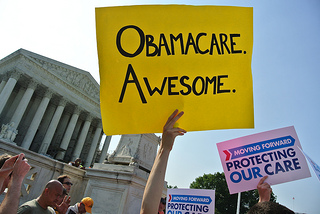A lot more good than you may realize — and definitely more than most of its opponents will ever admit.
 On a visit to Wisconsin on Thursday, President Obama celebrated the achievements of the Affordable Care Act (ACA), reminding voters of the disastrous consequences if a Republican is elected President and repeals the law known as Obamacare.
On a visit to Wisconsin on Thursday, President Obama celebrated the achievements of the Affordable Care Act (ACA), reminding voters of the disastrous consequences if a Republican is elected President and repeals the law known as Obamacare.
During his visit, President Obama had lunch with people who had written him letters about how the ACA has helped them, including Brent Brown, who has voted Republican all his life and had spoken out in strong opposition to the ACA. That all changed when he needed treatment for a serious health condition — and was able to get the care he needed thanks to Obamacare.
Here’s what Brown wrote in his letter, in part:
You saved my life. I want that to sink into your ears and mind. My President, you saved my life, and I am eternally grateful.
I have a ‘pre-existing condition’ and so could never purchase health insurance. Only after the ACA came into being could I be covered. Put simply to not take up too much of your time if you are in fact taking the time to read this: I would not be alive without access to care I received due to your law.
So thank you from a dumb young man who thought he knew it all and who said things about you that he now regrets. Thank you for serving me even when I didn’t vote for you.
Thank you for being my President.
Brown’s is just one story. There are millions of others, many of which I’ve told here at Eclectablog.
When you look at the bigger picture of how much good the ACA is doing for Americans, it’s even more impressive. Here are a few figures released by the White House in advance of his Wisconsin visit:
- 17.6 million consumers have gained health insurance thanks to the ACA, prior to this year’s open enrollment period. From 2010 through the first nine months of 2015, the uninsured rate has fallen by more than 40 percent and, for the first time ever, more than 9 in 10 Americans now have health insurance.
- As many as 129 million Americans who have some type of pre-existing health condition, including up to 19 million children, are now protected from coverage denials and reduced benefits – practices that were routine before the law’s enactment.
- 105 million Americans, including 39.5 million women and nearly 28 million children, have benefited from annual limits on out-of-pocket spending on essential health benefits – and the elimination of lifetime and annual limits on insurance coverage. These are protections that did not exist before the ACA.
- Americans now have access to critical preventive services at no cost, like flu shots, yearly check-ups, and birth control. These are benefits that did not exist before the ACA.
- Over 14 million more Americans have received coverage through Medicaid since the ACA’s first open enrollment period in 2013. States have an option to expand Medicaid to all non-eligible adults with incomes under 133 percent of the federal poverty level, and to date, 31 states and the District of Columbia have chosen to expand the program. In these states that have already expanded Medicaid, 4.4 million uninsured people will gain coverage. If the remaining states expand Medicaid, over 4 million more uninsured people would gain coverage.
- The ACA has provided new transparency in how health insurance plans disclose reasons for premium increases and requires simple, standardized summaries so over 170 million Americans can better understand their coverage information and compare plans. These consumer protections did not exist six years ago.
- 2.3 million young Americans gained coverage between 2010 and October 2013 because they could now stay covered on their parents’ health care plans until they turn 26 – a benefit that did not exist before the law.
- The ACA created tax credits that, as of September 2015, have helped 7.8 million Americans who otherwise often could not afford it purchase health coverage through the Health Insurance Marketplaces.
- Health insurers are now required to provide consumers with rebates if the amount they spend on health benefits and quality of care, as opposed to advertising and marketing, is too low. Last year, 5.5 million consumers received nearly $470 million in rebates. Since this requirement was put in place in 2011 through 2014, more than $2.4 billion in total refunds will have been paid to consumers.
- Out-of-pocket costs have been eliminated for preventive services like immunizations, certain cancer screenings, contraception, reproductive counseling, obesity screening, and behavioral assessments for children. This coverage is guaranteed for more than 137 million Americans, including 55 million women.
- Out-of-pocket costs have been eliminated for 39 million Medicare beneficiaries for preventive services like cancer screenings, bone-mass measurements, annual physicals, and smoking cessation.
- The ACA expands mental health and substance use disorder benefits and parity protections to over 60 million Americans.
- The ACA phases out the “donut hole” coverage gap for nearly 10.7 million Medicare prescription drug beneficiaries, who have saved an average of $1,945 per beneficiary.
And that’s just the beginning. In addition to the gains already made under Obamacare, the law is laying the groundwork to further reduce costs, improve care and make healthcare more accessible.
Of course, there’s still work to do in the health reform arena, but Republicans’ persistent refrain of “repeal and replace” just won’t get it done. In their own ways, the two Democratic candidates have the right idea: keep advancing healthcare reform for the good of all Americans.
[CC photo by Will O’Neill | Flickr]



